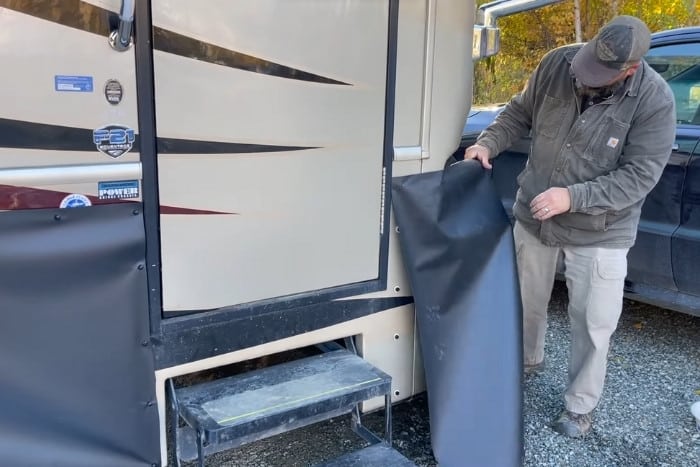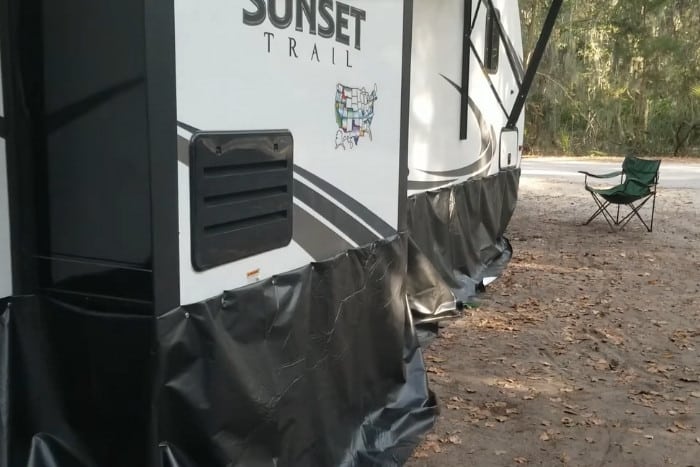RV living is a rewarding lifestyle with plenty of freedom and adventure, but staying in an RV during winter can become an endurance test. Your living space can plummet to unbearably low temperatures, and in cold conditions, there’s a high likelihood that plumbing pipes can freeze over and crack, leading to costly repairs.
RV skirting absolutely helps protect your RV against cold winter climates. Some ‘four season’ RVs may come equipped with ‘Arctic packages’ and additional winter-proofing, which may reduce the need for skirting. Cost-wise and comfort-wise, skirting is highly recommended.
How does RV skirting help? Do some skirting materials help more than others? Read on to ensure you have all the details before adding skirting to your home on wheels.
Fundamentals Of RV Skirting
1. Does RV Skirting Help Protect Your RV in Winter?
RV skirting offers important protection from harsh weather conditions, which may affect your ability to live comfortably in your RV during winter by shielding the vulnerable underside of your vehicle.
The protection RV skirting offers is multiple-fold. Firstly, it helps insulate your RV to ensure that temperatures in your living and sleeping areas remain bearable despite the cold outside.
High-quality skirting can reduce heat loss by up to a quarter and helps to reduce the amount of power. Whether it’s propane or electricity, you will need to heat your RV to maintain a comfortable temperature.
Skirting can also provide valuable protection from wind. In blustery weather, there is a high risk of wind permeating through the floor of your RV, which is often the least insulated part of your vehicle.
Skirting can mitigate this and help ensure you don’t wake up to freezing flooring on a winter’s morning.
Finally, if installed correctly, skirting is a vital defense mechanism against the havoc frozen conditions can play on your RV’s water pipes.
If temperatures outside get too cold, there is a high risk that your RV’s plumbing pipes could freeze and crack. Holding tanks also face a similar likelihood of damage in inclement conditions.
Although frozen pipes mean a temporary lack of water supply, a cracked pipe or storage tank means an extensive and expensive repair job.
Skirting offers valuable protection against frozen water pipes by maintaining a warmer core temperature at the underside of your vehicle.
It can also make it easier for you to thaw pipes in the unfortunate event that they do become frozen.
Although skirting, particularly custom-made varieties, can be expensive, it is less costly than the potential damage that can occur if essential parts of your RV freeze and need repairing or replacing.

2. At What Temperatures Does RV Skirting Help?
RV skirting is a key winter-proofing strategy if you are venturing to locations where temperatures drop below freezing.
Water in your plumbing can begin to freeze after exposure to continuous low temperatures.
If you are ‘wintering’ at a milder location where the thermometer isn’t likely to drop too low, then skirting may be an unnecessary expense for you.
However, it is helpful to remember that skirt insulation works both ways and can help protect against extreme heat damage to your vehicle and uncomfortably hot temperatures inside your RV.
It can also make for more comfortable winter living temperatures even if they do not drop below freezing.
3. Does RV Skirting Help ‘Four Season’ RVs?
Some RVs are specially designed to cope with year-round weather.
These four-season RVs have been designed and built with a protected undercarriage with heat conducted to plumbing parts to reduce the risk of pipes freezing and being damaged.
These vehicles are much better prepared to withstand winter conditions as the RV’s most ‘at risk’ areas are provided with much-needed heat.
While this added layer of protection may mean that skirting is less vital than standard RVs, it can still help four-season RVs function better as a living space in winter.
Skirting will make the heating system around your pipes and holding tank more efficient, ensuring less heat loss and helping you to reduce your energy costs.
Some low point drains may also poke out from the heated undercarriage on four-season RVs and still be at risk of becoming frozen.
Skirting can help protect these exposed areas and offset the limitations of the four-season package design.
Although you may be able to survive winter without it in a specially designed RV, skirting undoubtedly still helps protect your vehicle and can give you that extra peace of mind that you will get through winter issue-free.
4. Are Some Types of Skirting More Helpful Than Others?
Skirting comes in various forms. All are helpful to protect against inclement conditions. However, the extent to which they will assist you with RV living depends on the skirting type and quality.
From vinyl, plywood, foamboard, hay bales, or snow, many materials help protect your RV from the elements.
Some RVers opt for DIY options that can absolutely help reduce the effects of cold weather on your vehicle.
One risk, however, is that the material is flammable or attracts insects that also shelter from colder conditions (for example, hay bales) which can cause other problems in the long run.
Alternatively, many companies offer custom-made, tailor-fitted skirting designed for your RV.
A well-fitted insulation layer can undoubtedly offer the best help against cooler conditions, but this may come with a hefty price tag as costs can amount to well over $2000.
You should also consider how easily skirting can be reused and stored within the RV during warmer months.
Some campgrounds have strict rules about the state of skirting on RVs when allowing vehicles to stay in their parks over winter, so bear this in mind if you are considering a more cost-effective solution.
DIY skirting may help your RV bear the weather conditions, but it’s not much use if it limits your location choices in winter.

5. Is There Anything Else That Makes Skirting More Effective?
Although skirting is a vital tool in winter-proofing your RV, there are additional steps you can take to make your RV as winter-ready as possible. Here is a brief rundown of some key recommendations:
- Some full-time RV experts recommend using thermal insulating material (like Reflectix) around the windows, skylights, vents, and low point drains to prevent freezing.
- Others put an electric heater underneath the RV at a low or medium temperature to keep pipes at a reasonable temperature.
- Installing a heated water hose is another key step in ensuring your water supply does not freeze.
- Compartmentalizing your inside space with a heavy curtain can minimize the energy you need to heat your living area.
- Installing electric heat vents can draw out condensation and moisture from your well-insulated home and prevent damp-related problems.
Final Thoughts
RV skirting is incredibly helpful if you live or stay in areas with low temperatures, regardless of your RV type.
Ensure that you choose a safe and compatible skirting option, depending on your budget and the temperatures your vehicle will be exposed to, and supplement this with additional heat-loss prevention measures to get maximum use out of this vital RV winter survival technique.
